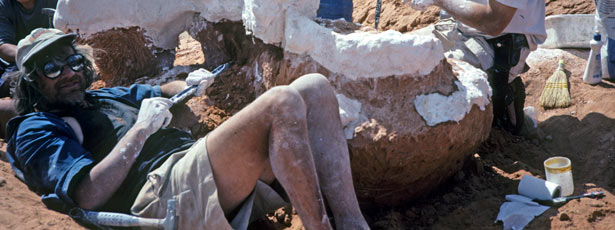Preparing for the Field
Collecting fossils is a complex operation and if you are unfamiliar with appropriate excavation techniques you can seriously harm the fossil itself and the site where it was found. In addition, you may damage other fossils that are present and lose vital information about the site.
For this reason, no one should attempt to excavate fossils unless they have the right equipment and expertise to remove them. If you are at all uncertain, then it is a good idea to contact a museum to get aid or advice from an experienced field collector in vertebrate paleontology. And in all cases, be certain to have the appropriate permission and permits to look for, and/or collect fossibles, be they on private or public lands.
Deciding where to look for fossils and preparing for a collecting trip are in-depth topics outside the scope of this site. For an introduction, read Procedures in Collecting Fossil Vertebrates a nine-page document by Charles R. Schaff of Harvard’s Museum of Comparative Zoology. This covers:
- Useful attributes for a fossil collector
- Locating outcrops
- Where to find vertebrate fossils
- Base camp
- Public relations
- Tools and equipment
- Methods of collecting and excavation
- Excavating fossils
- Jacketing fossils
- Underwater screen washing
- Recording specimen and locality data
- Localities using public land surveys
To learn more about the equipment and supplies recommended for the field, download The Field Equipment Checklist, a list of necessary and useful items for paleontological fieldwork, which was compiled by Marilyn Fox of the Yale Peabody Museum of Natural History.
Field work can be hazardous — you may be walking in remote areas; in hot, dry conditions or on wet slippery slopes; up and down hills; in areas where there may possibly be wild animals or poisonous snakes; and all the while carrying large and heavy objects. Visit the Health & Safety page in the Tools & Resources section for information on field safety tips. With proper preparation and awareness, the risks from these dangers can be minimized and all of your hard, dirty and backbreaking work may be rewarded with spectacular and scientifically significant fossils.


